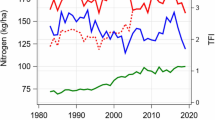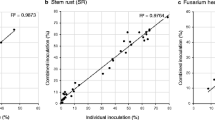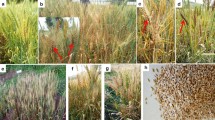Abstract
Fusarium head blight is one of the most important wheat diseases causing grain yield and quality losses as well as mycotoxin contamination all over the world. Since Fusarium cannot be reliably controlled with fungicides, breeding has become a favorable tool to decrease the infection severity. In most cases, selection for Fusarium resistance is done by artificial infection in the field. However, there is a risk in preferring late heading genotypes, because heading of wheat is negatively correlated to head blight severity. Because an indirect selection for late maturity is not intended, we considered a statistical approach to avoid this problem. In this paper, we propose a mixed model to analyze extensive Fusarium head blight rating in resistance breeding experiments of wheat. The objective of the analysis was to select for Fusarium resistance, while at the same time ensuring that late heading genotypes, which show less head blight over the shorter vegetation period, are not preferred. Thus, selection was to be done such that genetic variability for heading date was retained. Therefore, the statistical model contained a covariate to adjust for differences in the heading date. The use of covariate adjustment is an easily handled alternative to a bivariate analysis. Covariate adjustment will in practice often work almost equally well as bivariate analysis. Any statistical software with powerful mixed model analysis tools can be used for this type of analysis. We propose an ad hoc method to obtain heritability estimates and a form of LSD (least significance difference) as a measure of accuracy on the basis of the proposed model and under special consideration of the experimental design. The ad hoc LSD was used as a rough measure to judge rankings of genotypic means (BLUPs). Friedman’s super smoother was used to compare smoothed rank estimates for adjusted and unadjusted genotypes against increasing smoothed heading dates. Traits were transformed to meet the model assumptions, especially homogeneity of errors and normality, and back-transformation of means and standard errors was conducted by using the delta method.



Similar content being viewed by others
References
Bormann CA, Rickert AM, Castillo Ruiz RA, Paal J, Lübeck J, Strahwald J, Buhr K, Gebhardt C (2004) Tagging quantitative trait loci for maturity-corrected late blight resistance in tetraploid potato with PCR-based candidate gene markers. MPMI 17:1126–1138
Bradshaw JE, Pande B, Bryan GJ, Hackett CA, McLean K, Stewart HE, Waugh R (2004) Interval mapping of quantitative trait loci for resistance to late blight [Phytophthora infestans (Mont.) de Bary], height and maturity in a tetraploid population of potato (Solanum tuberosum subsp. tuberosum). Genetics 168:983–995
Bueno JSD, Gilmour SG (2003) Planning incomplete block experiments when treatments are genetically related. Biometrics 59:375–381
Buerstmayr H, Steiner B, Lemmens M, Ruckenbauer P (2000) Resistance to Fusarium head blight in winter wheat: heritability and trait associations. Crop Sci 40:1012–1018
Buerstmayr H, Steiner B, Hartl L, Griesser M, Angerer N, Lengauer D, Miedaner T, Schneider B, Lemmens M (2003) Molecular mapping of QTLs for Fusarium head blight resistance in spring wheat. II. Resistance to fungal penetration and spread. Theor Appl Genet 107:503–508
Buerstmayr H, Legzdina L, Steiner B, Lemmens M (2004) Variation for resistance to Fusarium head blight in spring barley. Euphytica 137:279–290
Butler D, Cullis BR, Gilmour AR, Gogel BJ (2003) Spatial analysis with mixed models with S-Plus. SAMM reference manual. Training series QE02001, NSW 24 Agriculture (pdf version)
Cullis BR, Smith A, Hunt C, Gilmour A (2000) An examination of the efficiency of Australian crop variety evaluation programmes. J Agric Sci 135:213–222
Cullis BR, Smith AB, Coombes NE (2006) On the design of early generation variety trials with correlated data. J Agric Biol Environ Stat 11:1–13
Eskridge KM, Mumm RF (1992) Choosing plant cultivars based on the probability of outperforming a check. Theor Appl Genet 84:894–900
Friedman JH, Silverman BW (1989) Flexible parsimonious smoothing and additive modeling. Technometrics 31:3–39
Friedman JH, Stuetzle W (1981) Projection pursuit regression. J Am Stat Assoc 76:817–823
Friedman JH, Stuetzle W (1982) Smoothing of scatterplots. Technical report Orion 003. Department of Statistics, Stanford University
Hinkelmann K, Kempthorne O (1994) Design and analysis of experiments. Introduction to experimental design, vol 1. Wiley, New York
Hochberg Y, Tamhane AC (1987) Multiple comparison procedures. Wiley, New York
Hsu JC (1996) Multiple comparisons. Chapman & Hall, London
Kackar RN, Harville DA (1984) Approximations for standard errors of estimators of fixed and random effects in mixed linear models. J Am Stat Assoc 79:853–862
Kelly A, Smith AB, Eccleston J, Cullis BR (2007) The accuracy of varietal selection using factor analytic models for multi-environment plant breeding trials. Crop Sci 47:1063–1070
Kuchel H, Hollamby G, Langridge P, Williams K, Jefferies SP (2006) Identification of genetic loci associated with ear-emergence in bread wheat. Theor Appl Genet 113:1103–1112
Leibbrandt VD, Ewan RC, Speer VC, Zimmerman DR (1975) Effect of weaning and age at weaning on baby pig performance. J Anim Sci 40:1077–1080
Mardia KV, Kent JT, Bibby JM (1988) Multivariate analysis. Academic Press, London
McMullen MP, Schatz B, Stover R, Gregoire T (1997) Studies of fungicide efficacy, application timing, and application technologies to reduce Fusarium head blight and deoxynivalenol. Cereal Res Commun 25:779–783
Miedaner T, Reinbrecht C, Lauber U, Schollenberger M, Geiger HH (2001) Effects of genotype and genotype × environment interaction on deoxynivalenol accumulation and resistance to Fusarium head blight in rye, triticale, and wheat. Plant Breed 120:97–105
Miedaner T, Heinrich N, Schneider B, Oettler G, Rohde S, Rabenstein F (2004) Estimation of deoxynivalenol (DON) content by symptom rating and exoantigen content for resistance selection in wheat and triticale. Euphytica 139:123–132
Miedaner T, Wilde F, Steiner B, Buerstmayr B, Korzun V, Ebmeyer E (2006) Stacking quantitative trait loci (QTL) for Fusarium head blight resistance from non-adapted sources in an European elite spring wheat background and assessing their effects on deoxynivalenol (DON) content and disease severity. Theor Appl Genet 112:562–569
Oakey H, Verbyla A, Pitchford W, Cullis B, Kuchel H (2006) Joint modelling of additive and non-additive genetic line effects in single field trials. Theor Appl Genet 113:809–819
Paterson LJ, Patterson HD (1984) An algorithm for generating alpha-lattice designs. ARS Combin 16A:87–98
Patterson HD, Williams ER (1976) A new class of resolvable incomplete block designs. Biometrika 63:83–92
Piepho HP (1998a) Empirical best linear unbiased prediction in cultivar trials using factor analytic variance–covariance structures. Theor Appl Genet 97:195–201
Piepho HP (1998b) Methods for comparing the yield stability of cropping systems—a review. J Agron Crop Sci 180:193–213
Piepho HP, Möhring J (2006) Selection in cultivar trials is it ignorable? Crop Sci 146:193–202
Piepho HP, Möhring J (2007) Computing heritability and selection response from unbalanced plant breeding trials. Genetics 177:1881–1888
Piepho HP, McCulloch CE (2004) Transformations in mixed models: application to risk analysis for a multienvironment trial. J Agric Biol Environ Stat 9:123–137
Piepho HP, van Eeuwijk FA (2002) Stability analyses in crop performance evaluation. In: Kang M (ed) Crop improvement: challenges in the twenty-first century. Haworth Press, New York, pp 315–351
Piepho HP, Büchse A, Emrich K (2003) A hitchhiker’s guide to the mixed model analysis of randomized experiments. J Agron Crop Sci 189:310–322
Piepho HP, Büchse A, Truberg B (2006a) On the use of multiple lattice designs and a-designs in plant breeding trials. Plant Breed 125:523–528
Piepho HP, Williams ER, Fleck M (2006b) A note on the analysis of designed experiments with complex treatment structure. HortScience 41:446–452
SAS Institute Inc (2004) SAS OnlineDoc® 9.1.2. SAS Institute Inc, Cary
Schmolke M, Zimmermann G, Buerstmayr H, Schweizer G, Miedaner T, Korzun V, Ebmeyer E, Hartl L (2005) Molecular mapping of Fusarium head blight resistance in the winter wheat population Dream/Lynx. Theor Appl Genet 111:747–756
Smith HF (1957) Interpretation of adjusted treatment means and regressions in analysis of covariance. Biometrics 13:282–308
Smith AB, Cullis BR, Gilmour AR (2001) The analysis of crop variety evaluation data in Australia. Aust N Z J Stat 43:129–145
Smith AB, Cullis BR, Thompson R (2005) The analysis of crop cultivar breeding and evaluation trials: an overview of current mixed model approaches. J Agric Sci Camb 143:449–462
Stuart A, Ord JK (1994) Kendall’s advanced theory of statistics, vol 1, 6th edn. Arnold Publishers, London
Tukey JW (1991) The philosophy of multiple comparisons. Stat Sci 6:100–116
Whitaker D, Williams ER, John JA (2002) CycDesigN: a package for computer generation of experimental designs. CSIRO Forestry and Forest Products, Canberra
Author information
Authors and Affiliations
Corresponding author
Additional information
Communicated by F. van Eeuwijk.
Appendix
Appendix
Back-transformation of means and standard errors
A genotype mean \( \bar x_{\text{i}} \) on the logit scale with standard error se i is back-transformed in the original scale by
and
In case of differences of genotype means (i.e., pairwise comparisons of genotype means) \( d = \bar x_1 - \bar x_2 \) we back-transformed the expectations and variances by
and
\( {\text{Var}}(\bar x_1 ),\,{\text{Var}}(\bar x_2 ) \) and \( {\text{Cov}}(\bar x_1 ,\bar x_2 ) \) are the variances and covariances of genotype means and covariances of genotype means on the transformed scale.
For back-transformation from the logit scale, the formulas for first and second-order derivatives are:
Rights and permissions
About this article
Cite this article
Emrich, K., Wilde, F., Miedaner, T. et al. REML approach for adjusting the Fusarium head blight rating to a phenological date in inoculated selection experiments of wheat. Theor Appl Genet 117, 65–73 (2008). https://doi.org/10.1007/s00122-008-0753-z
Received:
Accepted:
Published:
Issue Date:
DOI: https://doi.org/10.1007/s00122-008-0753-z




